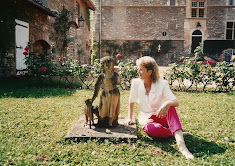CLUES 50* SPANISH - 50 STEPS - Grammar
WELCOME * BENVIDO * BEM VINDO * BIENVENUE * WÄLLKOMNA * WILLKOMMEN * ... TO this window-shop where you are FREE*ly offered several INFORMATION pages about our BOOK ...
* 50 clues - GRAMMAR *
|
Grammar
| 50 CLUES |
SPANISH |
SINOPSIS
This book has not been written to compete either with school-textbooks, neither with SPANISH GRAMMAR books of 500 or 800 pages, aimed at University students and teachers.
This is a work directed to students and/or teachers of Primary and Secondary schools who wish to have compiled in 1 volume the numerous RULES and EXCEPTIONS - concerning Morphology and Syntax - which are "scattered" along the more than eighty lessons that may include studies of Primary and Secondary courses.
Due to the book format and number of pages this GRAMMAR provides EASY handling.
The structure and summary tables will be EASY to understand and memorize.
Because of its 40 pages about "Special Difficulties", and its 33 models of IRREGULAR verbs, you had wished to have been able to consult it long ago.
Its "INDEX" General “50 CLUES” and Alphabetical will make searching EASY.
The INDEX entitled “50 STEPS” is for structuring the teaching in 50 progressive steps from minor to greater difficulty.
The information given in the ANNEX about SPAIN will be also very useful for you all.
* LIBRERÍA Avalon 2000 *
- Tannay GARDENS -

PROHIBIDA reprodución SIN permiso autor@
This book is not to be reproduced "in whole or in part" – neither is allowed the transmission, sale or storage by any form or means - either written text, images, illustrations, drawings, signs, graphs, maps, cover designs and graphic design, photography , layout and/or summary tables) - whether for processing, either electrical, mechanical, manual, chemical, optical, recording or photocopying, recording or by any other method, without the prior written permission of the owner of the intellectual property. The violation of these rights may constitute an offense against “Intellectual Property” (Article 270 of the Criminal Code).
Intellectual Property Registration * J.E.O. 00/2009/4005 * MADRID (Spain)
EDITORIAL Círculo Rojo € 39 (libro impreso) Julio 2013 / DESCUENTO 33% (Agosto 2015)
E-BOOK (blanco y negro) 9 €
VALENCIA * Flor de AZAHAR

- ORANGE blossoms -
Castillo TEMPLARIO (Ponferrada)

Castillo Templario * PONFERRADA (León)
sábado, 25 de marzo de 2017
miércoles, 15 de marzo de 2017
lunes, 13 de febrero de 2017
jueves, 2 de febrero de 2017
"CHAXIRAXI" y Nª Sª de las Candelas (TENÉRIFE) - Islas Canarias


Siglo XVIII Siglo XX
"Achmayex Guayaserax"
viernes, 20 de enero de 2017
DRUMs & BARRELs * MUSIC * 19 Enero 2017
sábado, 14 de enero de 2017
jueves, 5 de enero de 2017
martes, 3 de enero de 2017
miércoles, 21 de diciembre de 2016
martes, 22 de noviembre de 2016
sábado, 5 de noviembre de 2016
CATEDRAL Sagrada Familia * GAUDÍ y Cornet Antoni (1852 - 1926)
https://www.google.es/search?q=sagrada+familia+de+gaudi&rlz=1C1CHKW_esES458&biw=1215&bih=487&source=lnms&tbm=isch&sa=X&ved=0ahUKEwjd7f2GyZLQAhVHsBQKHeZaBMQQ_AUICCgB&dpr=1.13#imgdii=1K8eU8HEsuW43M%3A%3B1K8eU8HEsuW43M%3A%3BdjlqP53edW71tM%3A&imgrc=1K8eU8HEsuW43M%3A
SPAIN * ESPAÑA * ARTE románico... gótico... moderno
□ 1
|
San Pere de Rodes
|
GIRONA
|
España
|
□ 2
|
San Juan de la Peña
|
HUESC A
|
España
|
□ 3
|
Catedral
|
HUESCA
|
España
|
□ 4
|
Monasterio de Leyre
|
NAVARRA
|
España
|
□ 5
|
San Isidoro
|
LEÓN
|
España
|
□ 6
|
San Martín
|
FROMISTA
|
España
|
□ 7
|
Catedral de Santiago
|
COMPOSTELA
|
España
|
□ 8
|
Abadía - Monasterio
|
MOISSAC
|
Francia
|
□ 9
|
Notre Dame La Grande
|
POITIERS
|
Francia
|
□ 10
|
Catedral
|
SPIRA
|
Alemania
|
□ 11
|
Catedral de Cefalú
|
SICILIA
|
Italia
|
□ 12
|
Catedral
|
PISA
|
Italia
|
∆ 13
|
Abadía de Saint Denís
|
PARIS
|
Francia
|
∆ 14
|
Iglesia Catedral
|
CHARTRES
|
Francia
|
∆ 15
|
Iglesia Catedral
|
REIMS
|
Francia
|
∆ 16
|
Iglesia Catedral
|
BOURGES
|
Francia
|
∆ 17
|
Iglesia Catedral
|
AMIENS
|
Francia
|
∆ 18
|
Nôtre Dame
|
PARÍS
|
Francia
|
∆ 19
|
Iglesia Catedral
|
SALISBURY
|
Inglaterra
|
∆ 20
|
Iglesia Catedral
|
COLONIA
|
Alemania
|
∆ 21
|
Iglesia Catedral
|
SIENA
|
Italia
|
∆ 22
|
Iglesia Catedral
|
LEÓN
|
España
|
∆ 23
|
Catedral de Santa María
|
BURGOS
|
España
|
x 24
|
Santa SOFÍA
(Sª Sabiduría)
|
CONSTANTINOPLA
|
Turquía
(siglo VI)
|
x 25
|
San Basilio (9 Iglesias)
|
MOSCÚ
|
Rusia
|
۞ 26
|
Mezquita
|
CÓRDOBA
|
España
(siglo VIII)
|
۞ 27
|
Palacio del Al-Hambra
|
GRANADA
|
España
(siglo XIII)
|
z 28
|
Torre Eiffel
|
Alexandre G. EIFFEL
|
PARÍS
|
Francia
|
z 29
|
Estatua de la Libertad
|
Frédéric A.BARTHOLDI
|
NEW YORK
|
U.S.A.
|
z 30
|
Catedral de
|
Antoni GAUDÍ
|
BARCELONA
|
España
|
miércoles, 19 de octubre de 2016
martes, 18 de octubre de 2016
PREPOSICIONES * Frases prepositivas
domingo, 9 de octubre de 2016
miércoles, 5 de octubre de 2016
HOMOPHONE words * with or without ortographic ACCENT ¡?!
Dado que en el idioma ESPAÑOL tenemos muchas palabras
2) La "B" y la "V" las pronunciamos igual.
3) Algo similar pasa entre la "S" y la "X".
4) La "LL" y la "Y".
5) entre PALABRAS con acento o sin él.
con ACENTO
|
sin ACENTO
|
él
|
he (subject pronoun)
|
el
|
the (definite masc. article)
| |
tú
|
you ( “ “ )
|
tu
|
yours (adj. possessive)
| |
té
|
tea (noun)
|
te
|
you (object pronoun)
| |
mí
|
me (object pronoun)
|
mi
|
my & a musical note
| |
sí
|
yes (adverb)
|
si
|
if (conjunction)
| |
dé
|
him to give (Present Subj)
|
de
|
of (preposition)
| |
sé
|
I know (Pres simpl
|
se
|
(pages 20 – 23 & Syntax )
| |
éste
|
this one (poss. pronoun )
|
este
|
this (possessive adjective)
| |
ése
|
that one ( “ “ )
|
ese
|
that ( “ “ )
| |
aquél
|
that one over there (“ “)
|
aquel
|
that over there ( “ “ )
| |
cómo
|
how (question word)
|
I eat (Pres simp Indic)
| ||
qué
|
what ( “ “ )
|
que
|
that (conjunction)
| |
más
|
more (adverb)
|
mas
|
but (conjunct. adversative)
| |
sólo
|
only (adverb)
|
solo
|
alone (adjective)
|

















